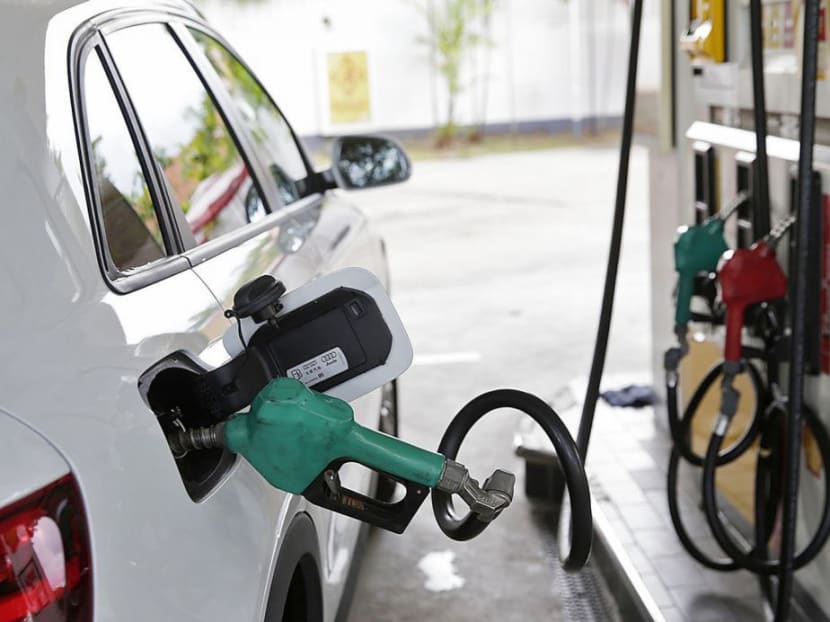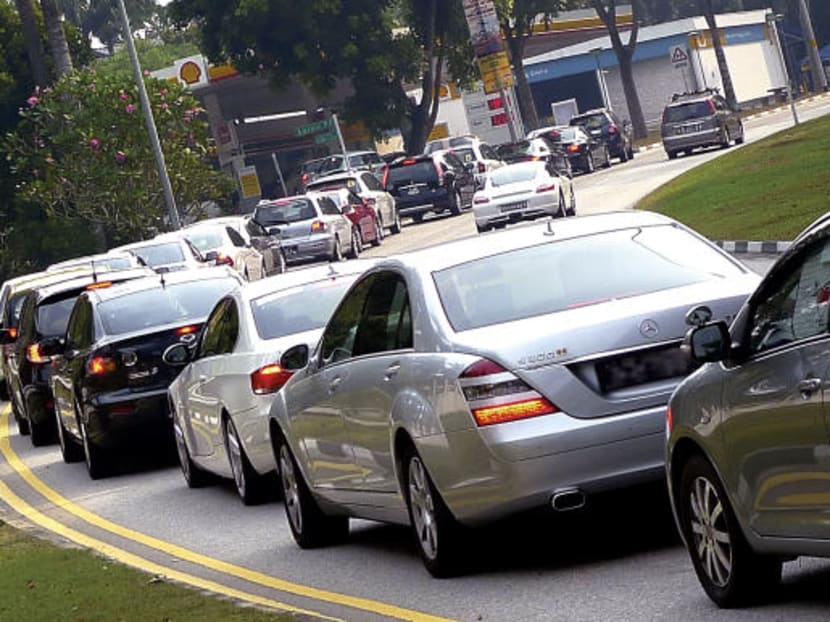Motorists overspend as much as S$40m a year on petrol: Report
SINGAPORE — The competition watchdog may develop a web portal or mobile app that lets motorists compare petrol prices, aimed at spurring more transparent competition among petrol retailers and helping consumers make more informed choices.

While the competition watchdog found no evidence that retailers were colluding to fix petrol prices, it said there was scope for greater transparency. TODAY file photo
SINGAPORE — The competition watchdog may develop a web portal or mobile app that lets motorists compare petrol prices, aimed at spurring more transparent competition among petrol retailers and helping consumers make more informed choices.
While it found no evidence that retailers were colluding to fix prices, the Competition Commission of Singapore (CCS) said they do regularly monitor and react to each other’s listed retail petrol prices and promotions so as to retain customers or win new customers.
But even when petrol retailers list similar prices, motorists may be paying very different amounts, said the CCS, noting that the myriad discounts offered by the players through rebates, loyalty programmes, and promotions vary between 5 per cent and 20 per cent. Across the board, motorists are wasting as much as S$40 million each year because they do not have a clear idea of the effective petrol prices across brands.
“Discount and rebate schemes can be complicated and make price comparisons difficult for consumers. If information on effective prices, i.e. retail prices net of petrol discounts and rebates, were made more simple and readily available, consumers would be able to compare effective prices easily and hence, make more informed petrol purchase decisions,” the CCS said on Tuesday (Dec 19). “This would in turn facilitate a more price-competitive retail petrol market in Singapore, as petrol retailers would need to offer better prices and promotions to retain or attract customers.”
When contacted, the petrol retailers said they were looking into the findings and recommendations.
An ExxonMobil spokesman said: “We have noted the CCS’ recommendations and are looking into how we can incorporate these.”
“Shell is closely studying the findings from the Competition Commission of Singapore on the market inquiry on retail petrol prices in Singapore and is unable to comment at this stage,”added a Shell Singapore spokesman.
The other two petrol retailers - Singapore Petroleum Company (SPC) and Chevron Corporation – which owns the Caltex chain of petrol stations, did not reply to queries from TODAY.
Releasing its findings from its further inquiry into the retail petrol market here, the CCS said nearly three in five (58 per cent) motorists stuck to the same petrol brand between 2012 and last year, citing the convenient location of the retailer, and their satisfaction with the perks they are getting, among the top reasons.
Only one in five (22 per cent) compared prices diligently. Generally, those who monitor petrol prices across brands through comparison websites or mobile apps save more than those who look at displays on-site or visit petrol retailers’ websites.
Several mobile apps and websites have sprung up in recent years, offering not only comparison of petrol prices in Singapore but money saving tips for motorists as well.
One such portal is iMoney, which provides information on the savings which can be accrued from credit cards and loyalty cards. Noting the “constantly fluctuating prices”, its spokesman said: “Owning a car is an expensive affair in Singapore, and petrol makes up a big portion of that monthly expenses. This makes getting up-to-date prices crucial to cutting petrol spending.”
Motorists are also spending unnecessarily on a higher grade of petrol than their vehicles need, the CCS found, adding it would continue to raise consumer awareness in this issue. Three in five (63 per cent) do so, despite studies showing that there is no difference to engine performance when one uses a higher petrol grade than recommended by the vehicle manufacturer.
Experts here concurred.
Assistant Professor Dr Yang Wenming, of the National University of Singapore's Department of Mechanical Engineering, said the difference is "almost negligible".
“Using high grade petrol has no obvious impact on fuel consumption for motorists. Even under lab conditions, only a very minor improvement can be found, under actual road running, the difference is almost negligible.”
“The performance of the motorcycle and vehicle is mainly determined by the engine itself and drivers' driving habits. But high grade petrol may reduce the poisonous emissions,” added Dr Yang.
This latest round of inquiry into the retail petrol market was sparked in February 2015 based on feedback that prices had not fallen in tandem with crude oil price declines – this fell from US$115 from June 19, 2014 to US$46 on Jan 12, 2015.
The CCS sought to understand how petrol retailers’ pricing process, and motorists’ purchasing habits by studying commercially sensitive and confidential information from industry players, consulting experts from overseas competition authorities, local banks, and apps that compare petrol prices, as well as speaking to motorists.
Motorists that TODAY interviewed said their minds are set on going for higher grade fuel at the pumps, citing the perception that it is better for their cars.
Executive Hannah Chua, 36, said: “I can feel the difference when driving, acceleration is faster. It's not a marked improvement, but definitely noticeable.” She uses 95 grade petrol.
But 47-year-old engineer Mr Andrew Tan, who goes for the highest 98 grade, felt: “I don't think there is much difference, but I feel that in the long run, petrol that's more expensive might be better for my car.”

PROFITS UP FOR PETROL RETAILERS
SINGAPORE — Despite their costs of doing business rising in recent years, the four petrol retailers’ profits here increased, the competition watchdog has found.
But it was not because there was a “rocket and feather” pattern in pricing, it said, describing pump prices rising faster or more when costs go up, and dropping slower and less when they fall.
Rather, it was likely because there is limited competition here in outpricing each other, said the Competition Commission of Singapore (CCS), in its report on a second inquiry into market practices in Singapore’s petrol industry released on Tuesday (Dec 19).
It said non-fuel costs that have risen in recent years include operating costs, levy and taxes, land costs, and the discounts and rebates offered.
For instance, in 2010, wholesale petrol costs was the biggest component of pump prices, accounting for 41 per cent. This was followed by levy and taxes (28 per cent), then discounts and rebates (14 per cent). Operating income and cost was 14 per cent at that time.
In 2015, levy and taxes (32 per cent) became the biggest component of pump prices, followed by wholesale petrol costs (29 per cent). Discounts and rebates edged up to make up 16 per cent of prices, but operating income and cost sprang to 20 per cent.
Between that time, retail petrol price rose from S$1.87 to S$2.13. Wholesale petrol cost component dropped from S$0.77 to S$0.62, although this was partially offset by levy and taxes rising from S$0.52 to S$0.68.
All four petrol retailers here — Chevron, ExxonMobil, Shell, and Singapore Petroleum Company — import and refine crude oil into distillate products, including petrol, through their refinery plants in Singapore. A portion of the petrol is sold through their network of petrol stations here.









